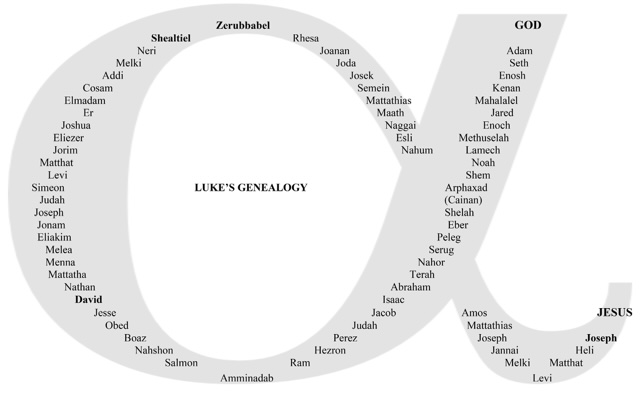
All the Genealogies of the Bible: A fascinating author interview
Today I’m happy to introduce you to the work of Dr. Nancy S. Dawson, author of All the Genealogies of the Bible (Zondervan Academic). The book is a new, wonderful reference work that released this past fall. Here’s an interview I did with her:
SG: Dr. Dawson, I love all the genealogical charts and commentary you’ve given readers that cover the figures of both Old and New Testaments. It’s a thick, hardback book. It must have taken years! How did this project come about?
ND: My background is in the sciences—an M.S. in botany/plant taxonomy and a PhD in cell biology. After several faculty appointments, our family moved to North Carolina. There, I had the opportunity to fulfill a dream to study theology at Duke Divinity School. While taking classes, I was looking for a book on biblical genealogies. I found several papers that addressed the genealogies of select biblical books—like the book of Genesis—or those of specific individuals. I even found commentary on genealogically rich chapters like 1 Chronicles 1–9. But I didn’t find a single comprehensive reference book on biblical genealogies. At the prompting of the Holy Spirit, I really felt called to write this book. And so, this was the beginning of a detailed investigation to document all the genealogies in the Old and New Testaments.
SG: Fascinating. So doubtless it took you a long time to research and write this book….
ND: I began about twenty years ago, reading methodically through the Bible with the aim of documenting and curating the genealogical sections. I didn’t really know what to expect. But having familiarity with plant classification systems (kingdom-phylum-class-order-family-genus-species), I could readily see how familial relationships were expressed in Scripture.
SG: Who would have guessed a background in plant classification systems could aid someone in biblical studies? What was your process?
ND: At first, I drafted the genealogical charts by hand. Later, I converted them to MS WORD documents, which I printed out and kept in sequential notebooks. These allowed me to thumb back-and-forth to see how the heritage of a given person(s) or a family was presented across the canon. For example, typically, I would find the ancestors of a certain family described first in Genesis; “branching” parts of the genealogical tree might continue in 1 or 2 Samuel; and, finally, the search would terminate with descendants in 1 Chronicles. So in this regard, I “constructed” the genealogies from various places in Scripture and kept track of the familial relationships for individuals, families, clans, and tribes of Israel in easy-to-follow genealogical charts. These I arranged canonically according to where the main individual was introduced.
SG: In what sections of the Bible did you find your material?
ND: Genealogies are a type of literary genre, in the same way you find historical narratives, poetry and wisdom, Gospels, and epistles. Genealogies are found in almost every book of the Bible, though we find many more in the OT than the NT—in about a 4:1 ratio. The presence of these genealogies alone confirms their importance. The sub-sections that stand out are multi-fold: the first family, the antediluvians, the post-diluvians, patriarchs (and some matriarchs), leaders of Israel (especially each of the 12 tribes), judges, kings, the Aaron and Eli high priesthood, the Levitical priesthood, scribes, prophets, and key individuals in the NT, such as Paul and church leaders.
One of my goals was to document the ancestral line of the Messiah as it appeared in the OT, so I consistently indicated that lineage in the charts I created. The book is 608 pages. All together there are a total 288 charts, arranged canonically, comprised of 252 in the OT , 23 from the NT, and an additional 13 supplemental charts. There are 80 pages of Subject and Scripture Indices, so it is easy to look up a person or scripture of interest.
SG: What do you mean by “supplemental”?
ND: The supplemental charts are found at the back of the book and include the genealogies for the rulers in the worlds of Bible characters: pharaohs of the 12th and 18th dynasties of Egypt (i.e., which relate to the stories of Joseph and Moses), all 77 high priests of Israel, the rulers of Assyria, Babylon, Persia, the Ptolemies, Seleucids, and Maccabees, Josephus, the Roman emperors, and rulers of Palestine from 336 BC–AD 66.
SG: So you used sources outside of the Bible?
ND: I drew on the works of Josephus and many reliable outside sources for developing the supplement charts. Other than those, though, I confined my inquiry almost exclusively to the biblical text. For a few NT charts about Jesus, his immediate family, and the ancestry of Mary and Joseph, I did consult extrabiblical genealogical information from church tradition and the apocryphal literature. But I was careful about using such content for obvious reasons. And I rejected any genealogical information that I deemed spurious, legendary, or in direct opposition to the scriptural account. Information deemed to be consistent with or at least complementary to well-understood genealogies and patterns in the biblical text, I evaluated and considered for inclusion. In the final version, I clearly marked anything of an extrabiblical nature.
SG: Did you encounter any surprises?
ND: There were actually a lot! I found that the genealogy for Jesus’s ancestry in Luke 3 is the single longest (linear/father-son) genealogy in all of scripture. The genealogy with the most depth and breadth (20+ generations) is that of the tribe of Judah (1 Chron 4). From Judah’s tribe issued the kings of Judah; Bethlehemites; founders of cities within the land allotted to Judah; a judge of Israel (Jair); families of military men under King David; an important scribe in Israel’s history (Elishama, who was probably responsible for composing the 1 Chronicles 1–9 section); an enigmatic figure, Jabez, who formed a scribal community near Jerusalem with Kenites and Rechabites (the descendants of Jael); royal potters; and wise men—to name a few!
Interestingly, I also found a double line of the Messiah that can be traced from two of David and Bathsheba’s sons (Solomon and Nathan), showing how there is chiastic crossover between the Matthew 1 genealogy (kingly line) and the Luke genealogy (non-kingly line) (see charts below). Additionally, the OT chart given at 1 Chronicles 3 for the Genealogy of Zerubbabel and Shealtiel (Jesus’s ancestors), incorporates the Matthew and Luke genealogical material for Jesus and surprisingly shows that there are inherent alpha and omega (infinity) signs [cf. Revelation 1:8; 21:6; 22:13] evident within Jesus’s ancestry (see charts) and at least ten places in Jesus’s heritage where one woman, in succession, marries two different men (for example Bathsheba was originally married to Uriah before she became David’s wife; Ruth was originally married to Mahlon before she became the wife of Boaz). This results in both biological and legal offspring in the line of the Messiah. (I discussed this in an excursus to the 1 Chronicles 3 chart about Zerubbabel and Shealtiel).
I show how offspring are acquired by typical biological succession, but also show many places where there is evidence of legal sons/heirs who are gained by adoption or levirate marriage; places where a son-in-law or brother-in-law is gained by marriage; and places where foreigners join the larger covenant family by marriage or assimilation.
Importantly, I was able to show how the Matthew 1 and Luke 3 genealogies for Jesus can be harmonized. To my knowledge this is the first time that the ancestry of Jesus the Messiah has been fully and carefully explained in the scholarly literature.
SG: That alone is a marvelous feat! I’m so glad you did this work. I noticed Dr. Eugene H. Merrill’s name on the cover. A scholar’s scholar…
ND: Two great scholars added their expertise to the project. Dr. Eugene H. Merrill from Dallas Theological Seminary was contributing author for the OT. He helped write portions of the commentary for the OT charts. And then Andreas J. Köstenberger was a fine NT contributing editor. He helped with many dates and read the charts critically that I had composed. All the people on the editorial staff at Zondervan Academic also helped assure that the book is a robust and accurate work.
SG: How has your work been received?
ND: The book is now in its second printing.
SG: Excellent! Where can people find All the Genealogies of the Bible?
ND: Through Amazon, Christianbook.com and on the Zondervan Academic website.
SG: No doubt it will serve as a valuable reference tool for students, scholars, pastors, and teachers for years to come. Thanks for your good work.
Readers, did you know Jesus’s maternal grandmother’s name was Anna, married to Joachim? You can find all kinds of fascinating information like this in Dr. Dawson’s book. Highly recommended.





